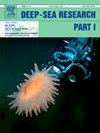评估气候变化对阿曼湾溶解氧的影响
IF 2.1
3区 地球科学
Q2 OCEANOGRAPHY
Deep-Sea Research Part I-Oceanographic Research Papers
Pub Date : 2025-03-14
DOI:10.1016/j.dsr.2025.104487
引用次数: 0
摘要
本文采用数值模拟方法研究了气候变化对阿曼湾溶解氧(DO)浓度的影响。我们模拟并比较了阿曼湾在历史(1980-2000)和未来(2080-2100)时期的DO浓度。结果表明,在未来气候中,阿曼湾上游400 m的DO浓度水平将会降低。表层混合层平均DO浓度夏季下降0.4、0.5、0.7 mg/l,冬季下降0.2、0.3、0.4 mg/l。表层混合层下DO浓度夏季分别下降0.5、0.6和0.8 mg/l,冬季分别下降0.6、0.7和1 mg/l。波斯湾流出对阿曼湾水域的通风作用在未来也会减弱。未来的气候脱氧将使低氧水域向上扩张。夏季,DO >的表层平均厚度;在RCP 2.6、RCP 4.5和RCP 8.5情景下,2mg /l将分别从历史时期的40 m下降到约32、26和23 m。在RCP 2.6、RCP 4.5和RCP 8.5情景下,冬季低氧边界将分别从历史时期的100 m深度向91、84和80 m深度移动。本文章由计算机程序翻译,如有差异,请以英文原文为准。
Assessment of the effects of climate change on dissolved oxygen in the Gulf of Oman
In this paper, we investigated the impacts of climate change on dissolved oxygen (DO) concentration in the Gulf of Oman using numerical modeling. We simulated and compared the DO concentration of the Gulf of Oman through the historical (1980–2000) and future (2080–2100) periods. Results demonstrated that in the future climate, the DO concentration levels in the upper 400 m of the Gulf of Oman will decrease. In the surface mixed layer, the mean DO concentration will decrease by 0.4, 0.5, and 0.7 mg/l in summer, and by 0.2, 0.3, and 0.4 mg/l in winter. Below the surface mixed layer, the mean DO concentration will decrease by 0.5, 0.6, and 0.8 mg/l in summer, and by 0.6, 0.7, and 1 mg/l in winter. The ventilation effect of the Persian Gulf outflow on the Gulf of Oman's water will also decrease in the future. The future climate deoxygenation will expand hypoxic waters upward. In summer, the mean thickness of the surface layer with DO > 2 mg/l will decrease from 40 m in the historical period to approximately 32, 26, and 23 m in the RCP 2.6, RCP 4.5, and RCP 8.5 scenarios, respectively. In winter, the hypoxic boundary will shift from 100 m depth in the historical period to about 91, 84, and 80 m in RCP 2.6, RCP 4.5, and RCP 8.5 scenarios, respectively.
求助全文
通过发布文献求助,成功后即可免费获取论文全文。
去求助
来源期刊
CiteScore
4.60
自引率
4.20%
发文量
144
审稿时长
18.3 weeks
期刊介绍:
Deep-Sea Research Part I: Oceanographic Research Papers is devoted to the publication of the results of original scientific research, including theoretical work of evident oceanographic applicability; and the solution of instrumental or methodological problems with evidence of successful use. The journal is distinguished by its interdisciplinary nature and its breadth, covering the geological, physical, chemical and biological aspects of the ocean and its boundaries with the sea floor and the atmosphere. In addition to regular "Research Papers" and "Instruments and Methods" papers, briefer communications may be published as "Notes". Supplemental matter, such as extensive data tables or graphs and multimedia content, may be published as electronic appendices.

 求助内容:
求助内容: 应助结果提醒方式:
应助结果提醒方式:


